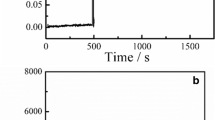Abstract
An aqueous rechargeable lithium battery (ARLB) using an electroactive polymer, polypyrrole (PPy), as a negative electrode; a lithium ion intercalation compound LiCoO2 as a positive electrode; and Li2SO4 aqueous solution as an electrolyte and its working mechanism are described. The charge/discharge process is associated with the doping/un-doping of anions at the negative electrode and intercalation/deintercalation of lithium ions at the positive electrode. The average output voltage of the PPy//LiCoO2 battery is about 0.85 V. This battery exhibits excellent cycling performance. This new technology solves the major problem of poor cycling life of ARLBs and will provide a new strategy to explore advanced energy storage and conversion systems.



Similar content being viewed by others
References
Wu YP, Dai XN, Ma JQ, Cheng YJ (2004) Lithium ion batteries: practice & applications. Chemical Industry, Beijing
Van der Linden S (2006) Energy 31:3446. doi:10.1016/j.energy.2006.03.016
Pietro BD, Patriarca M, Scrosati B (1982) J Power Sources 8:289. doi:10.1016/0378-7753(82)80062-1
Whittingham MS (1976) Science 192:1126. doi:10.1126/science.192.4244.1126
Li W, Dahn JR, Wainwright D (1994) Science 264:1115. doi:10.1126/science.264.5162.1115
Glanz J (1994) Science 264:1084. doi:10.1126/science.264.5162.1084
Wang GJ, Fu LJ, Zhao NH, Yang LC, Wu YP, Wu HQ (2007) Angew Chem Int Ed 46:295. doi:10.1002/anie.200603699
Wang GJ, Zhang HP, Fu LJ, Wang B, Wu YP (2007) Electrochem Commun 9:1873. doi:10.1016/j.elecom.2007.04.017
Wang GJ, Qu QT, Wang B, Shi Y, Tian S, Wu YP (2008) ChemPhysChem 9:2299. doi:10.1002/cphc.200800424
Stejskal J, Omastová M, Fedorova S, Prokeš J, Trchová M (2003) Polymer (Guildf) 44:1353. doi:10.1016/S0032-3861(02)00906-0
Huang K, Wan MX, Long YZ, Chen ZJ, Wei Y (2005) Synth Met 155:495. doi:10.1016/j.synthmet.2005.06.013
Blinova NV, Stejskal J, Trchova M, Prokes J, Omastova M (2007) Eur Polym J 43:2331. doi:10.1016/j.eurpolymj.2007.03.045
Eapen A, Joe IH, Aruldhas G (1997) J Solid State Chem 133:423. doi:10.1006/jssc.1997.7498
Novak P, Muller K, Santhanam K, Haas O (1997) Chem Rev 97:207. doi:10.1021/cr941181o
Winter M, Besenhard JO, Spahr ME, Novák P (1998) Adv Mater 10:725. doi:10.1002/(SICI)1521-4095(199807)10:10<725::AID-ADMA725>3.0.CO;2-Z
Mizushima K, Jones PC, Wiseman PJ, Goodenough JB (1980) Mater Res Bull 15:783. doi:10.1016/0025-5408(80)90012-4
Markevich E, Salitra G, Aurbach D (2005) Electrochem Commun 7:1298. doi:10.1016/j.elecom.2005.09.010
Wang GJ, Qu QT, Wang B, Zhang HP, Wu YP, Holze R (2009) Electrochim Acta 54:1199. doi:10.1016/j.electacta.2008.08.047
Ruffo R, Wessells C, Huggins RA, Cui Y (2009) Electrochem Commun 11:247. doi:10.1016/j.elecom.2008.11.015
Panero S, Spila E, Scrosati B (1996) J Electrochem Soc 143:L29. doi:10.1149/1.1836446
Feldberg SW (1984) J Am Chem Soc 106:4671. doi:10.1021/ja00329a004
Wang GJ, Fu LJ, Wang B, Zhao NH, Wu YP, Holze R (2008) J Appl Electrochem 38:589
Wang GJ, Zhao NH, Yang LC, Wu YP, Holze R, Wu HQ (2007) Electrochim Acta 52:4911. doi:10.1016/j.electacta.2007.01.051
Acknowledgments
Financial support from National Basic Research Program of China (973 Program No: 2007CB209702) and Alexander von Humboldt Foundation (Institutional Program) is greatly appreciated.
Author information
Authors and Affiliations
Corresponding authors
Rights and permissions
About this article
Cite this article
Wang, G.J., Yang, L.C., Qu, Q.T. et al. An aqueous rechargeable lithium battery based on doping and intercalation mechanisms. J Solid State Electrochem 14, 865–869 (2010). https://doi.org/10.1007/s10008-009-0869-3
Received:
Revised:
Accepted:
Published:
Issue Date:
DOI: https://doi.org/10.1007/s10008-009-0869-3




